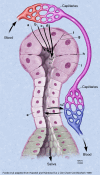Salivary biomarkers: toward future clinical and diagnostic utilities
- PMID: 24092855
- PMCID: PMC3811231
- DOI: 10.1128/CMR.00021-13
Salivary biomarkers: toward future clinical and diagnostic utilities
Abstract
The pursuit of timely, cost-effective, accurate, and noninvasive diagnostic methodologies is an endeavor of urgency among clinicians and scientists alike. Detecting pathologies at their earliest stages can significantly affect patient discomfort, prognosis, therapeutic intervention, survival rates, and recurrence. Diagnosis and monitoring often require painful invasive procedures such as biopsies and repeated blood draws, adding undue stress to an already unpleasant experience. The discovery of saliva-based microbial, immunologic, and molecular biomarkers offers unique opportunities to bypass these measures by utilizing oral fluids to evaluate the condition of both healthy and diseased individuals. Here we discuss saliva and its significance as a source of indicators for local, systemic, and infectious disorders. We highlight contemporary innovations and explore recent discoveries that deem saliva a mediator of the body's physiological condition. Additionally, we examine the current state of salivary diagnostics and its associated technologies, future aspirations, and potential as the preferred route of disease detection, monitoring, and prognosis.
Figures








References
-
- Hu S, Loo JA, Wong DT. 2007. Human saliva proteome analysis. Ann. N. Y. Acad. Sci. 1098:323–329 - PubMed
Publication types
MeSH terms
Substances
Grants and funding
LinkOut - more resources
Full Text Sources
Other Literature Sources
Medical

